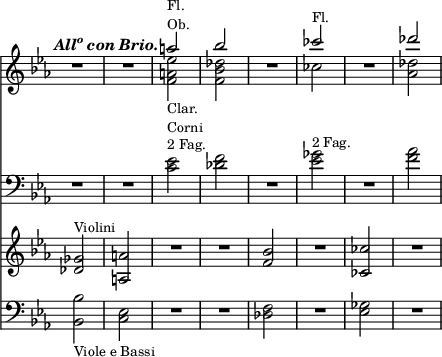to indicate the Chords intended to be filled in on the Organ or Harpsichord. The Symphonies are played by the Violins, in unison, with a similar 'Thoroughbass' accompaniment; and the entrance of these instruments, between the vocal passages, is marked by a contrast as striking as it is agreeable. In the following example, from the 'Messiah,' the Chords indicated by the figures—which no one who claims to be considered a 'Musician' ought to find any difficulty in filling in at sight—are printed in small notes.

In some of his Songs, Handel has enlarged upon this method; as in 'Lascia ch'io pianga,' from 'Rinaldo,' the first part of which is accompanied by the full Stringed Band, and the second by a 'Thoroughbass' only, the Violins and Viola reappearing at the Da capo. It is impossible to believe that the great Composers of the last century, with Handel and Bach at their head, adopted this style of accompaniment without having duly considered its effect: and any attempt to heighten that effect by 'additional accompaniments'—by whomsoever designed—shews as little reverence for Art as would be evinced by a desire to cover the Madonna di San Sisto with 'additional glazings.' The Songs are perfect as they stand: and the contrast they display is as marked in its degree as that in the celebrated passage from Beethoven's Fifth Symphony (in C minor), in which the Stringed Instruments and Wood Wind are made to answer each other in alternate Chords—

This last expedient is by no means uncommon in modern music; and has been most successfully used by Mendelssohn in his Overture to 'A Midsummer Night's Dream,' where a few sustained notes on the Wind Instruments are contrasted with the rapid passage for four Violins with excellent effect. The Trio, for Brass Instruments, in the Minuet of Sterndale Bennett's Symphony in G minor, is another striking instance of fine and quite unexpected contrast: and cases abound in which Composers of Instrumental Music have treated the several sections of the Orchestra very much in the way in which vocal writers treat alternate Choirs, producing thereby innumerable beautiful effects of bold relief, and strongly contrasted tone.
IV. Variety of colouring results from the judicious blending together of the several elements which we have just considered as opposed to each other in more or less violent contrast. In the Instrumentation of the Great Masters this quality is always conspicuous: in that of inferior writers never. Its presence may, indeed, be regarded as one of the surest possible indications of true genius, which never fails to attain it in the face of any amount of difficulty.
In the 18th century Handel wrought marvels with the slender means at his command: with Trumpets and Oboes in the opening movements of the 'Occasional Overture' and the 'Dettingen Te Deum'; with Oboes and Bassoons in 'The Lord is a man of War'; with Flutes and Horns in 'Surge procelle, ancora'; with a somewhat larger number of Wind Instruments in 'Wise men flattering'; but often, as in 'Angels ever bright and fair,' with the Stringed Band alone, and always with infinite variety of tone and expression. Sebastian Bach anticipated, in like manner, many of our most highly-prized modern effects, as in the delicious combination of Horn
